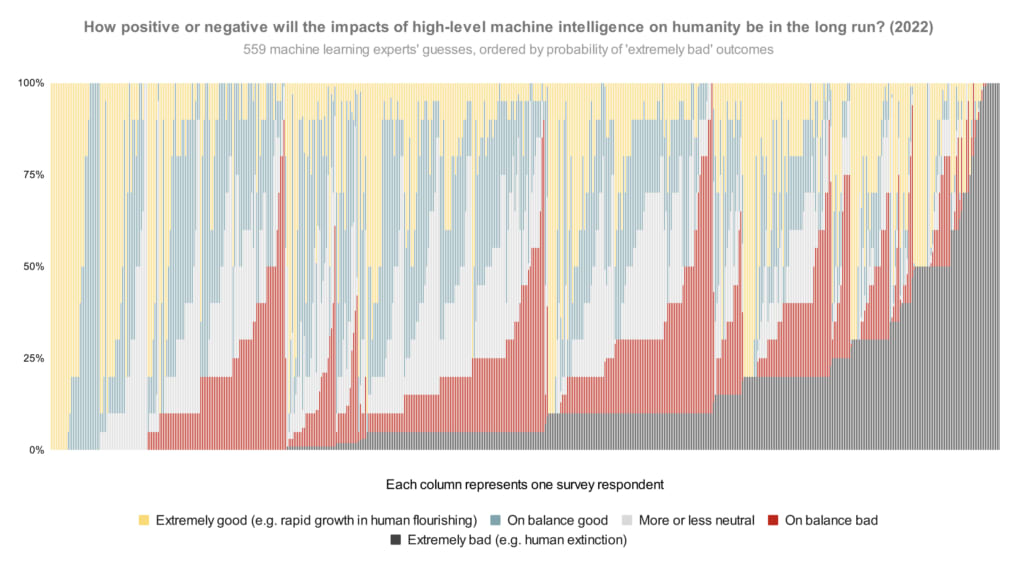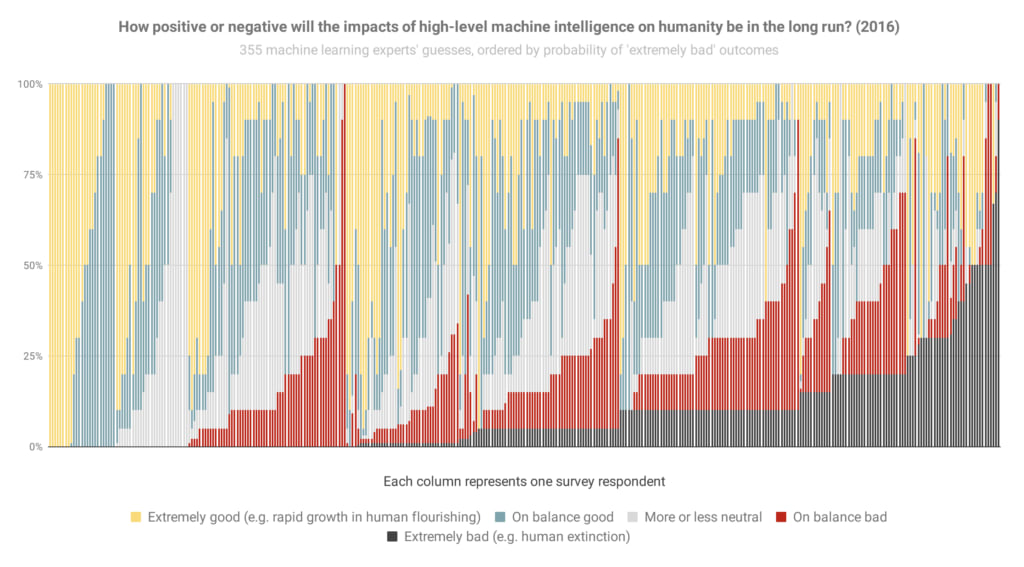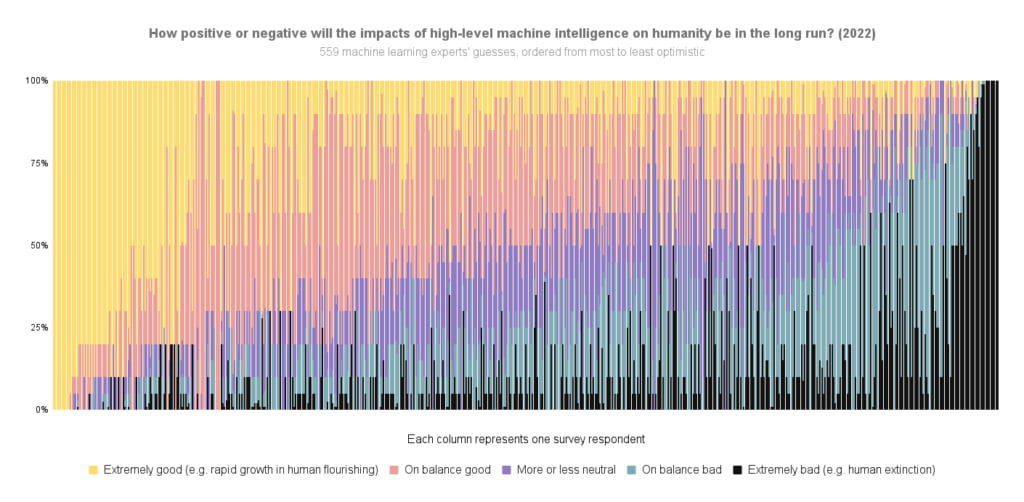Katja Grace, 8 March 2023
In our survey last year, we asked publishing machine learning researchers how they would divide probability over the future impacts of high-level machine intelligence between five buckets ranging from ‘extremely good (e.g. rapid growth in human flourishing)’ to ‘extremely bad (e.g. human extinction).1 The median respondent put 5% on the worst bucket. But what does the whole distribution look like? Here is every person’s answer, lined up in order of probability on that worst bucket:

And here’s basically that again from the 2016 survey (though it looks like sorted slightly differently when optimism was equal), so you can see how things have changed:

The most notable change to me is the new big black bar of doom at the end: people who think extremely bad outcomes are at least 50% have gone from 3% of the population to 9% in six years.
Here are the overall areas dedicated to different scenarios in the 2022 graph (equivalent to averages):
- Extremely good: 24%
- On balance good: 26%
- More or less neutral: 18%
- On balance bad: 17%
- Extremely bad: 14%
That is, between them, these researchers put 31% of their credence on AI making the world markedly worse.
Some things to keep in mind in looking at these:
- If you hear ‘median 5%’ thrown around, that refers to how the researcher right in the middle of the opinion spectrum thinks there’s a 5% chance of extremely bad outcomes. (It does not mean, ‘about 5% of people expect extremely bad outcomes’, which would be much less alarming.) Nearly half of people are at ten percent or more.
- The question illustrated above doesn’t ask about human extinction specifically, so you might wonder if ‘extremely bad’ includes a lot of scenarios less bad than human extinction. To check, we added two more questions in 2022 explicitly about ‘human extinction or similarly permanent and severe disempowerment of the human species’. For these, the median researcher also gave 5% and 10% answers. So my guess is that a lot of the extremely bad bucket in this question is pointing at human extinction levels of disaster.
- You might wonder whether the respondents were selected for being worried about AI risk. We tried to mitigate that possibility by usually offering money for completing the survey ($50 for those in the final round, after some experimentation), and describing the topic in very broad terms in the invitation (e.g. not mentioning AI risk). Last survey we checked in more detail—see ‘Was our sample representative?’ in the paper on the 2016 survey.
Here’s the 2022 data again, but ordered by overall optimism-to-pessimism rather than probability of extremely bad outcomes specifically:

For more survey takeaways, see this blog post. For all the data we have put up on it so far, see this page.
See here for more details.
Thanks to Harlan Stewart for helping make these 2022 figures, Zach Stein-Perlman for generally getting this data in order, and Nathan Young for pointing out that figures like this would be good.

Katja - thanks for posting these survey data.
They results are shocking. Really shocking. Appalling, really. It's worth taking a few minutes to soak in the dark implications.
It's hard to imagine any other industry full of smart people in which researchers themselves realize that what they're doing is barely likely to have a net positive impact on the world. And in which a large proportion believe that they're likely to impose massive suffering and catastrophe on everyone -- including their own friends, families, and kids.
Yet that's where we are with the AI industry. Almost all of the ML researchers seem to understand 'We might be the baddies'. And a much higher proportion seem to understand the catastrophic risks in 2022 than in 2016.
Yet they carry on doing what they're doing, despite knowing the risks. Perhaps they're motivated by curiosity, hubris, wealth, fame, status, or prestige. (Aren't we all?) Perhaps these motives overwhelm their moral qualms about what they're doing.
But IMHO, any person with ethical integrity who found themselves working in an industry where the consensual prediction among their peers is that their work is fairly likely to lead straight to an extinction-level catastrophe would take a step back, re-assess, and re-think whether they should really be pushing ahead.
I know all the arguments about the inevitability of AI arms races, between companies and between nation-states. But we're not really in a geopolitical arms race. There are very few countries with the talent, money, GPU clusters, and determination to pursue advanced AI. North Korea, Iran, Russia, and other dubious nations are not going to catch up any time soon. China is falling behind, relatively speaking.
The few major players in the American AI industry are far, far more advanced than the companies in any other country at this point. We're really just talking about a few thousand ML researchers associated with OpenAI/Microsoft, Deepmind/Google, and a handful of other companies. Almost all American. Pushing ahead, knowing the risks, knowing they're far in advance of any other country. It's insane. It's sociopathic. And I don't understand why EAs are still bending over backwards to try to stay friendly with this industry, trying to gently nudge them into taking 'alignment' more seriously, trying to portray them as working for the greater good. They are the baddies, and they increasingly know it, and we know it, and we should call them out on it.
Sorry for the feisty tone here. But sometimes moral outrage is the appropriate response to morally outrageous behavior by a dangerous industry.
"Yet they carry on doing what they're doing, despite knowing the risks. Perhaps they're motivated by curiosity, hubris, wealth, fame, status, or prestige. (Aren't we all?) Perhaps these motives overwhelm their moral qualms about what they're doing."
I'd like to add inertia/comfort to this list: people don't like to change jobs, and changing fields is much harder.
Intervention idea: offer capabilities researchers support to transition out of the field